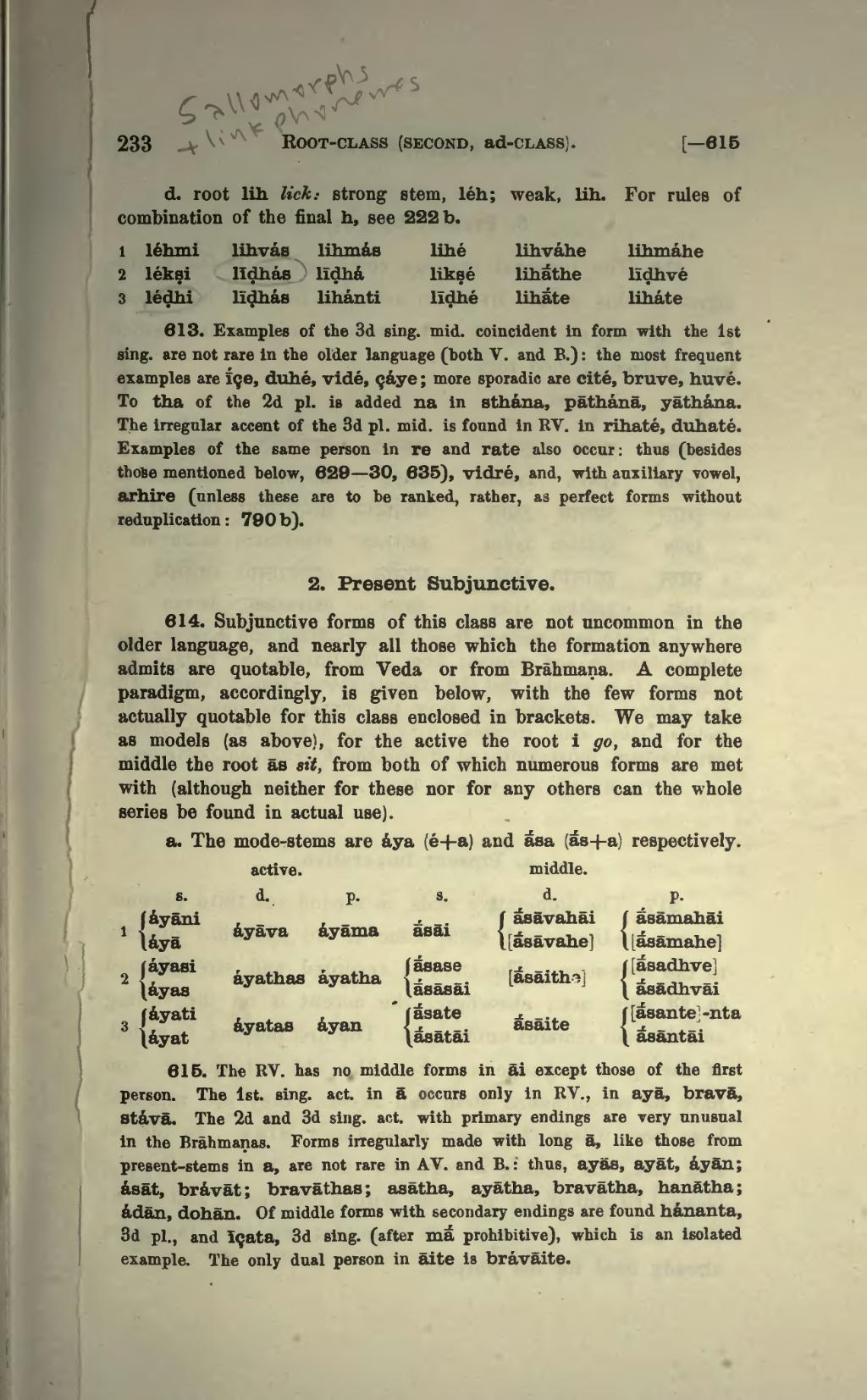d. root lih lick: strong stem, léh; weak, lih. For rules of combination of the final h, see 222 b.
| 1 | léhmi | lihvás | lihmás | lihé | lihváhe | lihmáhe |
| 2 | lékṣi | līḍhás | līḍhá | likṣé | lihā́the | līḍhvé |
| 3 | léḍhi | līḍhás | lihánti | līḍhé | lihā́te | liháte |
613. Examples of the 3d sing. mid. coincident in form with the 1st sing. are not rare in the older language (both V. and B.): the most frequent examples are ī́çe, duhé, vidé, çáye; more sporadic are cité, bruve, huvé. To tha of the 2d pl. is added na in sthána, pāthánā, yāthána. The irregular accent of the 3d pl. mid. is found in RV. in rihaté, duhaté. Examples of the same person in re and rate also occur: thus (besides those mentioned below, 629–30, 635), vidré, and, with auxiliary vowel, arhire (unless these are to be ranked, rather, as perfect forms without reduplication: 790 b).
2. Present Subjunctive.
614. Subjunctive forms of this class are not uncommon in the older language, and nearly all those which the formation anywhere admits are quotable, from Veda or from Brāhmaṇa. A complete paradigm, accordingly, is given below, with the few forms not actually quotable for this class enclosed in brackets. We may take as models (as above), for the active the root i go, and for the middle the root ās sit, from both of which numerous forms are met with (although neither for these nor for any others can the whole series be found in actual use).
a. The mode-stems are áya (é+a) and ā́sa (ā́s+a) respectively.
| active. | middle. | |||||
|---|---|---|---|---|---|---|
| s. | d. | p. | s. | d. | p. | |
| 1 | áyāni áyā |
áyāva | áyāma | ā́sāi | ā́sāvahāi [ā́sāvahe] |
ā́sāmahāi [ā́sāmahe] |
| 2 | áyasi áyas |
áyathas | áyatha | ā́sase ā́sāsāi |
[ā́sāithe] | [ā́sadhve] ā́sādhvāi |
| 3 | áyati áyat |
áyatas | áyan | ā́sate ā́sātāi |
ā́sāite | [ā́sante] -nta ā́sāntāi |
615. The RV. has no middle forms in āi except those of the first person. The 1st. sing. act. in ā occurs only in RV., in ayā, bravā, stávā. The 2d and 3d sing. act. with primary endings are very unusual in the Brāhmaṇas. Forms irregularly made with long ā, like those from present-stems in a, are not rare in AV. and B.: thus, ayās, ayāt, áyān; ásāt, brávāt; bravāthas; asātha, ayātha, bravātha, hanātha; ádān, dohān. Of middle forms with secondary endings are found hánanta, 3d pl., and īçata, 3d sing. (after mā́ prohibitive), which is an isolated example. The only dual person in āite is brávāite.
